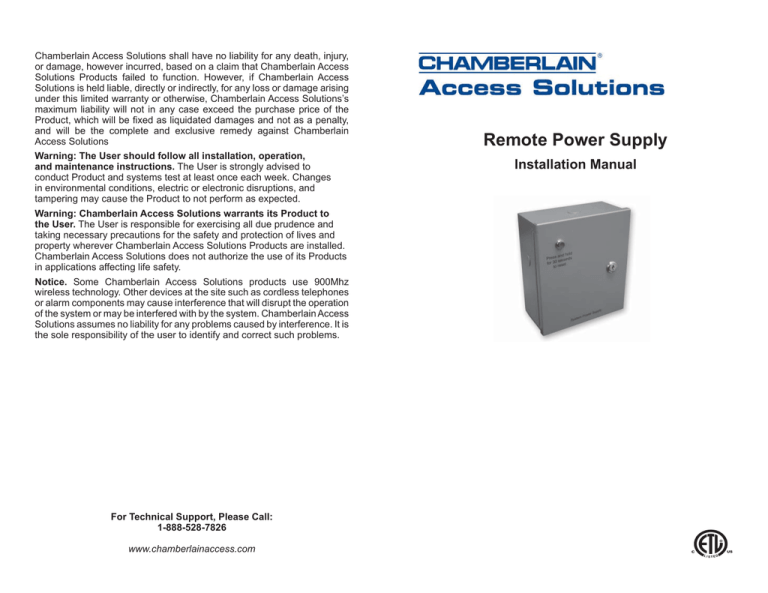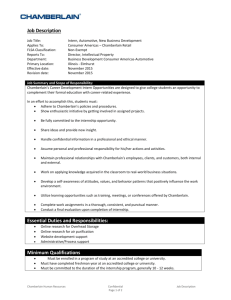
Chamberlain Access Solutions shall have no liability for any death, injury,
or damage, however incurred, based on a claim that Chamberlain Access
Solutions Products failed to function. However, if Chamberlain Access
Solutions is held liable, directly or indirectly, for any loss or damage arising
under this limited warranty or otherwise, Chamberlain Access Solutions’s
maximum liability will not in any case exceed the purchase price of the
Product, which will be fixed as liquidated damages and not as a penalty,
and will be the complete and exclusive remedy against Chamberlain
Access Solutions
Warning: The User should follow all installation, operation,
and maintenance instructions. The User is strongly advised to
conduct Product and systems test at least once each week. Changes
in environmental conditions, electric or electronic disruptions, and
tampering may cause the Product to not perform as expected.
Warning: Chamberlain Access Solutions warrants its Product to
the User. The User is responsible for exercising all due prudence and
taking necessary precautions for the safety and protection of lives and
property wherever Chamberlain Access Solutions Products are installed.
Chamberlain Access Solutions does not authorize the use of its Products
in applications affecting life safety.
Notice. Some Chamberlain Access Solutions products use 900Mhz
wireless technology. Other devices at the site such as cordless telephones
or alarm components may cause interference that will disrupt the operation
of the system or may be interfered with by the system. Chamberlain Access
Solutions assumes no liability for any problems caused by interference. It is
the sole responsibility of the user to identify and correct such problems.
For Technical Support, Please Call:
1-888-528-7826
www.chamberlainaccess.com
Remote Power Supply
Installation Manual
Thank you for purchasing the Remote Power Supply. While every effort
has been made to ensure the accuracy of the information in this document,
Chamberlain Access Solutions assumes no liability for any inaccuracies
contained herein. We reserve the right to change the information contained
herein at any time and without notice.
NOTE: This equipment has been tested and found to comply with the limits for a Class B
digital device, pursuant to Part 15 of the FCC Rules. These limits are designed to provide
reasonable protection against harmful interference in a residential installation. This equipment
generates, uses, and can radiate radio frequency energy and, if not installed and used in
accordance with the instructions, may cause harmful interference to radio communications.
However, there is no guarantee that interference will not occur in a particular installation. If
this equipment does cause harmful interference to radio or television reception, which can be
determined by turning the equipment off and on, the user is encouraged to try to correct the
interference by one or more of the following measures:
Reorient or relocate the receiving antenna.
Increase the separation between the equipment and receiver.
Connect the equipment into an outlet on a circuit different from that to which the receiver is
connected.
Consult the dealer or an experienced radio TV technician for help.
This Class B digital apparatus complies with Canadian ICES-003.
Cet appareil numérique de la classe B est conforme à la norme NMB-003 du Canada.
© 2009 Chamberlain Access Solutions
All rights reserved. No part of this publication may be reproduced,
transmitted, transcribed, or translated into any language in any form, by
any means, without written permission of Chamberlain Access Solutions.
114A3865
WARRANTY & DISCLAIMER
Chamberlain Access Solutions warrants its products and equipment to
conform to its own specifications and to be free from defects in materials
and workmanship, under normal use and service, for a period of two
years from the date of shipment. Within the warranty period, Chamberlain
Access Solutions will repair or replace, at its option, all or any part of
the warranted product which fails due to materials and/or workmanship.
Chamberlain Access Solutions will not be responsible for the dismantling
and/or re-installation charges. To utilize this warranty, the customer must
be given a Return Goods Authorization (RGA) number by Chamberlain
Access Solutions The customer must pay all shipping costs for returning
the product.
This warranty does not apply in cases of improper installation, misuse,
failure to follow the installation and operating instructions, alteration,
abuse, accident, tampering, natural events (lightning, flooding, storms,
etc.), and repair by anyone other than Chamberlain Access Solutions. This
warranty does not warrant the replacement of batteries that are used to
power our products.
This warranty is exclusive and in lieu of all other warranties, expressed or
implied, including but not limited to the implied warranties of merchantability
and fitness for a particular purpose. Chamberlain Access Solutions will
not be liable to anyone for any consequential or incidental damages for
breech of this warranty or any other warranties.
This warranty will not be modified or varied. Chamberlain Access Solutions
does not authorize any person to act on its behalf to modify or vary this
warranty. This warranty applies to Chamberlain Access Solutions products
only. All other products, accessories, or attachments used in conjunction
with our equipment, including batteries, will be covered solely by their own
warranty, if any. Chamberlain Access Solutions will not be liable for any
direct, incidental, or consequential damage or loss whatsoever, caused by
the malfunction of product due to products, accessories, or attachments
of other manufacturers, including batteries, used in conjunction with our
products.
The customer recognizes that a properly installed and maintained security
system may only reduce the risk of events such as burglary, robbery,
personal injury, and fire. It does not insure or guarantee that there will
be no death, personal damage, and/or damage to property as a result.
Chamberlain Access Solutions does not claim that the Product may not
be compromised and/or circumvented, or that the Product will prevent any
death, personal and/or bodily injury and/or damage to property resulting
from burglary, robbery, fire, or otherwise, or that the Product will in all
cases provide adequate warning or protection.
Chamberlain Access Solutions products should only be installed by qualified
installers. The customer is responsible for verifying the qualifications of the
selected installer.
7
CONTENTS
Case lock
Introduction ............................................................................................... 1
Installation Instructions ............................................................................. 2
STEP 3
Amperage Calculation ......................................................................... 4
LID
Reset Switch
DC+ (RED)
DC- (BLK)
DC- (BLK)
DC+ (RED)
Remote Power Supply Installation Diagram
Warranty & Disclaimer ............................................................................. 7
STEP 4
BATTERY
BAT- (BLK)
DC-
CASE
POWER SUPPLY BOARD
(NOTE: On 1 amp power
supply board, DC- and BATare the same terminal.)
STEP 2
6
TRANSFORMER
On 1 and 2
amp power
supplies only
5 4 3 2
SYSTEM
POWER
WIRES
STEP 5
TO FALCON
6
DC+
AC
AC
STEP 2
TRANSFORMER
On 4, 6, and 10
amp power
supplies only
TO REMOTES
DC- (BLK)
Battery Backup Calculation.................................................................. 5
Troubleshooting With LED Diagnostics ............................................... 5
BAT+ (RED)
DC+ (RED)
Voltage Calculation .............................................................................. 5
1
Voltage Calculation
Most remote power supplies require a minimum of 12V and a maximum
of 18V to run (AC or DC). The remote power supply is rated at a 12VDC
output at the stated amperage. Multiple power supplies may be required
to compensate for voltage drop over extremely long runs of wire or runs
with multiple remotes. Be sure that there is a minimum of 12V at each
remote. The following table shows the resistance per foot of wire for the
cable that we sell. If you are using another manufacturer’s wire, refer to
the specifications provided by that manufacturer. We strongly recommend
that you do NOT use wire gauges smaller than 18 AWG for power or data
when installing our gate system. Larger gauges are acceptable (16, 14,
12, and 10). For documentation on calculating voltage drops, visit our web
site at www.ptiaccess.com.
AWG
Ohms per 1000
feet of wire
Ohms per 100
feet of wire
Ohms per foot
of wire
18
60920
0.692
0.00692
16
4.459
0.446
0.00446
Battery Backup Calculation
Battery backup time is equal to the current draw (amps) multiplied by the
amp hour rating of the battery. For example: if the system draws 2 amps
and the battery is rated at 4 amp hours; the battery backup should last
for 8 hours if the battery is fully charged and all other conditions are right
(2 x 4 = 8). Certain external issues can influence this length of time, such
as the age and condition of the battery, damage to the battery or power
supply, power surges, and/or the level of charge in the battery. Also, each
time the remote is used while the AC power is out reduces the total backup
time as the current draw increases slightly when the keypad is in use. For
the battery backup function to be effective, the gate or door strike must
also have a separately powered battery backup.
Troubleshooting With LED Diagnostics
There are two light emitting diodes (LEDs) on the power supply circuit
board that can be used for troubleshooting. The red LED indicates DC
power and the green LED indicates AC power.
Red (DC)
Green (AC)
Troubleshooting Indication
ON
ON
Power supply is operating normally
ON
OFF
Loss of AC power, battery backup is supplying
power
OFF
ON
No DC output, indicating a short circuit or thermal
overload
OFF
OFF
Loss of AC power. Battery backup is not
functioning – battery disconnected or discharged
5
Amperage Calculation
INTRODUCTION
Use the chart below to verify that you have enough amps to support the
number of remote units to be installed. Do NOT exceed the 75% load for
the power supply. It is always better to have a higher amp power supply
than required as electronics will only pull the current that they need. Do not
confuse amperage with voltage, which must not exceed the specifications.
If you need assistance calculating your power needs, please contact
technical support.
The Remote Power Supply converts 120 VAC power to 12VDC and is
equipped with battery backup. The remote power supply comes in five
sizes (1, 2, 4, 6, and 10 amp) based on the amperage needed to support
the system. The power supplies also have a red reset button on the front
which allows you to interrupt the power and battery backup to reset the
entire system for troubleshooting purposes. Multiple power supplies can
be used to fit the needs of the particular setup.
Power Supply Size
Actual Amperage
Maximum Limit
(75% load)*
1 Amp
1.2 A
900 mA
2 Amp
3A
2250 mA
4 Amp
5A
3750 mA
6 Amp
7A
5250 mA
10 Amp
10 A
7500 mA
Remote Unit Type
Current Draw
Keypad or Keypad w/Intercom
300 mA
CodeXpress w/Intercom
300 mA
APEX Access Device
300 mA
Hardwired Multiplexer (16-96 Ch.)
300 mA
Wiegand **
300 mA **
8-Channel Relay Board
500 mA
Wireless Multiplexer
500 mA
Example:
1A power supply (900 mA max load) can support three keypads equaling 900 mA OR one
keypad and one 8-channel relay board totaling 800 mA. If you wanted to add any other
remotes in either case, you would have to move to the next larger power supply OR add an
additional 1A power supply. You would need a minimum of a 2A power supply to support two
8-channel relay boards (total 1000 mA). If you are unsure, always use the next size larger
remote power supply. It is always better to have more available amps than less as a remote
will only draw to its capacity and no more.
* Do NOT exceed 75% of load. This provides a safety zone to allow for most power spikes/
surges without locking up or damaging the system.
** When powering other equipment such as door strikes, HID readers, maglocks, or sirens
from a Wiegand, be sure to consider the current draw of that equipment.
4
Disclaimers and Warnings
We strongly recommend that installation and setup of Chamberlain
Access Solutions equipment be done by a certified, licensed, qualified,
and competent person. Chamberlain Access Solutions can recommend
local dealers and installers, but it is up to the customer to verify their
qualifications and negotiate any pricing or contracts unless Chamberlain
Access Solutions has been specifically contracted in writing to do so for the
customer. With any computer setup or installation, some troubleshooting and
adjustment of the configuration may be required. This will differ with every
installation and computer setup depending on operating system, software
installed, quality of components, internet connection, modem connection,
and any site-specific variables. Troubleshooting and configuration may
require purchasing additional equipment. Under no circumstances
will Chamberlain Access Solutions be responsible for any damages
either incidental or consequential based on these recommendations. All
installation of electronics and electrical systems must be in compliance with
local, municipal, and state codes, and the National Electrical Code.
Incorrect installation of electrical components can result in damage
to electronics as well as personal injury.
Cross-wiring the AC power with DC power will damage the
electronics.
Cross-wiring the positive and negative on the DC part of the
system will damage the electronics.
Connecting 120VAC directly to the power supply circuit board
bypassing the transformer will damage the electronics.
1
INSTALLATION INSTRUCTIONS
The following are instructions for installing a Remote Power Supply to
provide power for remote access devices. Please read this entire document
before proceeding and follow the steps in order. Refer to the diagram on
page 4 to reference the steps. If you need assistance or have questions
about this installation, please contact technical support at (888) 528-7826
or support@ptiaccess.com.
1. Mount the power supply case on the wall with solid anchoring
devices. The power supply battery and circuit board should be
left in the case as manufactured and not removed or installed
separately. Power supply cases are not weatherproof and should
be installed indoors. All power supplies for a site should be
installed together, centrally located in the office or a maintenance
room that will be accessible for future maintenance or service.
Each power supply should be clearly labeled inside the cover
to show which remotes are powered from it. If multiple power
supplies are being installed, refer to the Multiple Power Supply
Installation Guide available on our web site. Never power cameras,
door strikes, or sirens from the same power supply as remote
keypads and multiplexers as these items can cause power spikes,
underpowering the other remotes. Power supplies should be
installed near a 120 V wall outlet.
2. Feed the transformer cable through one of the four knockouts on
the sides of the power supply case using the correct bushing.
On 1 and 2 amp power supplies, connect the transformer cable
to the AC terminal connections on the power supply circuit board.
Spade connectors are required on all connections (do not wrap
wires around terminal connections). The transformer cable should
be 2-conductor cable with 18 gauge or larger conductors. Larger
gauge wire may be required for longer runs of wire. The transformer
cable and spade connectors for 1 and 2 amp power supplies must
be supplied by the installer.
The 4, 6, and 10 amp power supplies have an internally mounted
transformer that already has an electrical cord and plug attached.
3. Feed the system power wires through one of the four knockouts
on the sides of the power supply box using the correct bushing.
Connect system power wires to the stripped wires in the power
supply box (‘+’ to ‘+’ and ‘-‘ to ‘-‘). Secure this connection using
wire nuts or crimped connectors and seal with electrical tape
(whenever possible, these splices should also be soldered for
increased reliability).
2
WARNING: Do not connect the battery or transformer power until ready for use. Allow 48
hours of constant power for the battery to charge completely for battery backup.
4. On 1 and 2 amp power supplies, connect the transformer cable to
the wall transformer terminals. Spade connectors are required for
all connections (do not wrap wires around terminal connections).
5. Once the access control system has been wired and is ready for
use, remove the plastic insulating cover from the positive battery
terminal and connect the battery wires from the power supply
circuit board to the battery terminals. Be sure to connect ‘+’ to ‘+’
and ‘-‘ to ‘-‘.
Plug the transformer into a 120 V outlet. The Transformer can be
plugged into a UPS (uninterruptible power supply) or other surge
protector for added surge protection. Do not plug the power supply
into 120V until ready for use.
On 1 and 2 amp power supplies, connect the large external
transformer to the outlet using the screw provided on top of the
transformer to prevent the transformer from falling out of the socket
and removing power to the system.
The 4, 6, and 10 amp power supplies have an internally mounted
transformer with a standard electrical plug that does not require a
screw mount.
3



